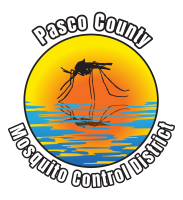SIT (Sterile Insect Technique )
Introducing a Promising Mosquito Control Tool:
(SIT) Sterile Insect Technique
The Pasco County Mosquito Control District is preparing to launch a proof-of-concept trial using sterilized male Aedes aegypti mosquitoes as part of our integrated mosquito management program. This trial will evaluate whether this innovative, environmentally friendly technique can help reduce populations of Aedes aegypti in our local area. Aedes aegypti is the primary mosquito species responsible for spreading dengue, Zika, chikungunya, and yellow fever.
What Is Sterile Insect Technique (SIT)?
SIT is not a new concept. In fact, it has been used successfully around the world for over 70 years to control pest populations such as fruit flies, screwworms, and tsetse flies. The technique involves releasing sterilized male insects that, when they mate with wild females, result in eggs that do not hatch. Over time, this leads to a gradual and targeted population decline in the release area.
This method has been recognized as a safe, sustainable, and species-specific form of pest control—and now it is being adapted for use against mosquitoes in protecting public health.


